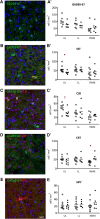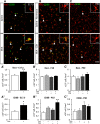Impaired Interneuron Development in a Novel Model of Neonatal Brain Injury
- PMID: 30809588
- PMCID: PMC6390196
- DOI: 10.1523/ENEURO.0300-18.2019
Impaired Interneuron Development in a Novel Model of Neonatal Brain Injury
Abstract
Prematurity is associated with significantly increased risk of neurobehavioral pathologies, including autism and schizophrenia. A common feature of these psychiatric disorders is prefrontal cortex (PFC) inhibitory circuit disruption due to GABAergic interneuron alteration. Cortical interneurons are generated and migrate throughout late gestation and early infancy, making them highly susceptible to perinatal insults such as preterm birth. Term and preterm PFC pathology specimens were assessed using immunohistochemical markers for interneurons. Based on the changes seen, a new preterm encephalopathy mouse model was developed to produce similar PFC interneuron loss. Maternal immune activation (MIA; modeling chorioamnionitis, associated with 85% of extremely preterm births) was combined with chronic sublethal hypoxia (CSH; modeling preterm respiratory failure), with offspring of both sexes assessed anatomically, molecularly and neurobehaviorally. In the PFC examined from the human preterm samples compared to matched term samples at corrected age, a decrease in somatostatin (SST) and calbindin (CLB) interneurons was seen in upper cortical layers. This pattern of interneuron loss in upper cortical layers was mimicked in the mouse PFC following the combination of MIA and CSH, but not after either insult alone. This persistent interneuron loss is associated with postnatal microglial activation that occurs during CSH only after MIA. The combined insults lead to long-term neurobehavioral deficits which parallel human psychopathologies that may be seen after extremely preterm birth. This new preclinical model supports a paradigm in which specific cellular alterations seen in preterm encephalopathy can be linked with a risk of neuropsychiatric sequela. Specific interneuron subtypes may provide therapeutic targets to prevent or ameliorate these neurodevelopmental risks.
Keywords: hypoxia; inflammation; interneurons; prematurity; psychiatric disorders.
Figures







Similar articles
-
Regenerative Therapies to Restore Interneuron Disturbances in Experimental Models of Encephalopathy of Prematurity.Int J Mol Sci. 2020 Dec 28;22(1):211. doi: 10.3390/ijms22010211. Int J Mol Sci. 2020. PMID: 33379239 Free PMC article.
-
Estrogen Treatment Reverses Prematurity-Induced Disruption in Cortical Interneuron Population.J Neurosci. 2018 Aug 22;38(34):7378-7391. doi: 10.1523/JNEUROSCI.0478-18.2018. Epub 2018 Jul 23. J Neurosci. 2018. PMID: 30037831 Free PMC article.
-
Interneuron NMDA Receptor Ablation Induces Hippocampus-Prefrontal Cortex Functional Hypoconnectivity after Adolescence in a Mouse Model of Schizophrenia.J Neurosci. 2020 Apr 15;40(16):3304-3317. doi: 10.1523/JNEUROSCI.1897-19.2020. Epub 2020 Mar 23. J Neurosci. 2020. PMID: 32205341 Free PMC article.
-
Cortical interneurons in schizophrenia - cause or effect?Croat Med J. 2023 Apr 30;64(2):110-122. doi: 10.3325/cmj.2023.64.110. Croat Med J. 2023. PMID: 37131313 Free PMC article. Review.
-
PV Interneurons: Critical Regulators of E/I Balance for Prefrontal Cortex-Dependent Behavior and Psychiatric Disorders.Front Neural Circuits. 2018 May 16;12:37. doi: 10.3389/fncir.2018.00037. eCollection 2018. Front Neural Circuits. 2018. PMID: 29867371 Free PMC article. Review.
Cited by
-
Preterm birth accelerates the maturation of spontaneous and resting activity in the visual cortex.bioRxiv [Preprint]. 2023 Apr 12:2023.01.20.524993. doi: 10.1101/2023.01.20.524993. bioRxiv. 2023. Update in: Front Integr Neurosci. 2023 May 15;17:1149159. doi: 10.3389/fnint.2023.1149159. PMID: 36711801 Free PMC article. Updated. Preprint.
-
Oxidative Stress-Induced Damage to the Developing Hippocampus Is Mediated by GSK3β.J Neurosci. 2022 Jun 15;42(24):4812-4827. doi: 10.1523/JNEUROSCI.2389-21.2022. Epub 2022 May 19. J Neurosci. 2022. PMID: 35589394 Free PMC article.
-
An Inexpensive Open-Source Chamber for Controlled Hypoxia/Hyperoxia Exposure.Front Physiol. 2022 Jul 12;13:891005. doi: 10.3389/fphys.2022.891005. eCollection 2022. Front Physiol. 2022. PMID: 35903067 Free PMC article.
-
Human 3D cellular model of hypoxic brain injury of prematurity.Nat Med. 2019 May;25(5):784-791. doi: 10.1038/s41591-019-0436-0. Epub 2019 May 6. Nat Med. 2019. PMID: 31061540 Free PMC article.
-
Regenerative Therapies to Restore Interneuron Disturbances in Experimental Models of Encephalopathy of Prematurity.Int J Mol Sci. 2020 Dec 28;22(1):211. doi: 10.3390/ijms22010211. Int J Mol Sci. 2020. PMID: 33379239 Free PMC article.
References
Publication types
MeSH terms
Grants and funding
LinkOut - more resources
Full Text Sources
Medical
Miscellaneous
